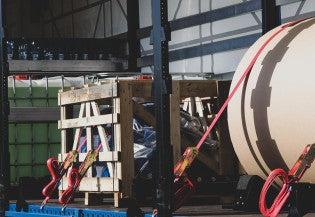How to do Load Securing in 7 Easy Steps
November 17, 2023 – Matthew Neumeier

Load securing in 7 steps
The road to safe cargo securing is step-by-step. Time and money can be saved by approaching the issue logically. Once proper packaging has been found and the load carrier chosen, cargo securing can begin.
How should you secure a load?
Once these 7 steps have been completed, the driver can safely hit the road:

1. Calculate the axle load
This is important for road and rail transport. There are standards for the maximum load per axle and violation of the standards can lead to hefty fines, delays and even the need to unload some of the goods.

2. Calculate the risk of overturning
Once the mass of the load and its dimensions are known, the centre of gravity can be calculated. A rule of thumb is that the centre of gravity should lie within the lower half of the cargo unit. If the centre of gravity is higher, there is a tipping risk and an appropriate securing method should be chosen, such as diagonal lashing.

3. Calculate the probability of sliding
This is calculated using the weight (mass force) and the coefficient of friction. Tables are helpful in making these calculations quickly.

4. Determine the lashing method
Choosing the right lashing method is partly indicated by the tipping hazard. If heavier objects are involved, lashing is in most cases unworkable from the outset. Too many straps are needed to keep the load in place, although anti-slip mats can be helpful here.

5. Choose lashing equipment
Straps and tensioning chains come in various shapes and sizes. The same applies to ratchet tensioners used to apply tension. These ratchets, for example, can have a short or long handle depending on the amount of tension they need to be able to produce. Here, attention must be paid not only to the required tension of the tensioning elements, but also to the strength of the load unit.
This must, of course, not be damaged by the tension applied to it. Preferably, always use new material and certainly not heavily worn or damaged material! Once the tensioning device has been chosen, the number must be determined. This is done as follows:
1. Calculate the number of tensioning devices required to prevent slipping
2. Calculate the number of tensioning means required to prevent tilting.
3. The highest result of the calculations above should be used.

6. Check the lashing points
Lashing points are usually steel eyes or holes in a rail in the load floor. They may look solid, yet their capacity should be checked. Preferably, do not put more than a single lashing device on a lashing point. Also check the capacity and condition of the lashing point or have it assessed by an expert. Deformations make a lashing point unusable.

7. Always work in a controlled manner
Instruments such as ratchet tensioners are designed for normal manual force. Where no specific tension is specified, but it is stated that simple tensioning of the lashing equipment is sufficient, do not do more than that. Do not apply additional force to further tighten the tensioning device, as the forces acting on the tensioning device during transport can be very high.
The load may be damaged and weak or damaged tensioning devices may break.
Care should also be taken when the person securing the load cannot fully oversee the situation. A lashing strap with metal clamps or hooks that is conveniently thrown over the load when lashing down may hit someone on the other side of the vehicle. Those handling tools should always be able to overlook everything and should never just assume that there is unlikely to be anyone in places they cannot see.
If you would like to learn more about load securing, we are happy to assist! Fill out our contact form and we will be in touch soon.



